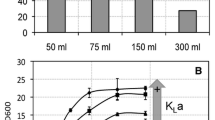Abstract
Long lasting batch cultures of Azospirillum brasilense SP 7 ATCC 29145 grown in liquid malate medium for 8–14 days without any fixed nitrogen source exhibited a biphasic nitrogenase activity, when incubated under gas atmospheres of 99.0% N2 and 1.0% O2 or 99.5% N2 and 0.5% O2 respectively. Maximum specific nitrogenase activity was 1100 nmol C2H4·mg protein-1·h-1. Poly-3-hydroxybutanoic acid (PHBA) synthesis and growth of the cells also showed two phases. Maxima and minima of glutamine synthetase activity developed synchronously with nitrogenase activity, whereas those of glutamate dehydrogenase and alanine aminotransferase were reverse. During a 192 h period of growth protein increased 3–4-fold and PHBA 25 fold. At maximum accumulation of the polymer the PHBA-nitrogen ratio was 6:1 or 8:1. Azospirillum brasilense was also able to fix nitrogen on agar surfaces exposed to air, but nitrogen fixation was monophasic under these conditions during a 14 d period. Specific nitrogenase activity was dependent on the type and concentration of the source of fixed nitrogen (leucine, ammonia) in solidified media. With 1 mM leucine maximum specific nitrogenase activity was 110 nmol C2H4·mg protein-1·h-1.
Similar content being viewed by others
Abbreviations
- PHBA:
-
poly-3-hydroxybutanoic acid
- TAPS:
-
tris(hydroxymethyl)methylaminopropane sulfonic acid
- TES:
-
N-tris(hydroxymethyl)methyl-2-aminoethane sulfonic acid
- TRICINE:
-
N-tris(hydroxymethyl)methylglycine
- TRIS:
-
tris(hydroxymethyl)aminomethane
References
Ahmad, M. H.: Influence of nitrogen on growth, free amino acids and nitrogenase activity in Spirillum lipoferum. J. Gen. Appl. Microbiol. 24, 271–278 (1978)
Balandreau, J., Miller, C., Weinhard, P., Ducerf, P., Dommergues, Y.: Etudes des variations de la fixation d'azote dans une culture de mais. C.R. Acad. Sci. Paris 282, Sér. D. 1071–1074 (1976)
Barber, L. E., Tjepkema, J. D., Russel, S. A., Evans, H. J.: Acetylene reduction (nitrogen fixation) associated with corn inoculation with Spirillum. Appl. Environ. Microbiol. 32, 108–113 (1976)
Bradford, M. M.: A rapid and sensitive method for the quantitation of microgram of protein utilizing the principle of protein-dye binding. Anal. Biochem. 72, 248–254 (1976)
Dawes, E. A., Senior, P. J.: The role and regulation of energy reserve polymers in microorganisms. Adv. Microbal Physiol. 10, 135–266 (1973)
Day, J. M., Döbereiner, J.: Physiological aspects of N2-fixation by a Spirillum from Digitaria roots. Soil Biol. Biochem. 8, 45–50 (1976)
Döbereiner, J.: N2-fixation associated with non-leguminous plants. In: Genetic Engineering for Nitrogen Fixation (A. Hollaender, ed.), pp. 451–461. New York, London: Plenum Press 1977
Döbereiner, J., Burris, R. H., Hollaender, A. (eds.): Limitations and Potentials for Biological Nitrogen Fixation in the Tropics. New York, London: Plenum Press 1978
Döbereiner, J., Day, J. M.: Associative symbioses in tropical grasses: characterization of microorganisms and dinitrogen fixing sites. In: Symposium on nitrogen fixation, Vol. 2 (Newton, W. E., Newman, C. J., eds.), pp. 518–538. Washington State Univ.: Washington State Univ. Press 1975
Herbert, D., Phipps, P. J., Strange, R. E.: Chemical analysis of microbial cells. In: Methods in Microbiology, Vol. 5B (Norris, J. R., Ribbons, D. W., eds.), pp. 209–344. New York: Academic Press 1971
Krieg, N. R.: Studies of Spirillum lipoferum. In: Genetic Engineering for Nitrogen Fixation (Hollaender, A., ed.), pp. 463–472. New York, London: Plenum Press 1977
Krieg, N. R., Tarrand, J. J.: Taxonomy of the root-associated nitrogen fixing bacterium Spirillum lipoferum. In: Limitations and Potentials for Biological Nitrogen Fixation in the Tropics (Döbereiner, J., Burris, R. H., Hollaender, A., eds.), pp. 317–333. New York, London: Plenum Press 1978
Law, J. H., Slepecky, R. A.: Assay of poly-β-hydroxybutyric acid. J. Bacteriol. 82, 33–36 (1961)
Okon, Y., Albrecht, S. L., Burris, R. H.: Factors affecting growth and nitrogen fixation of Spirillum lipoferum. J. Bacteriol. 127, 1248–1254 (1976a)
Okon, Y., Albrecht, S. L., Burris, R. H.: Carbon and ammonia metabolism of Spirillum lipoferum. J. Bacteriol. 128, 592–597 (1976b)
Okon, Y., Houchins, J. P., Albrecht, S. L., Burris, R. H.: Growth of Spirillum lipoferum at constant partial pressures of oxygen, and the properties of its nitrogenase in cell-free extracts. J. Gen. Microbiol. 28, 87–93 (1977)
Schoner, W.: L-(-)-Malat: Bestimmung mit Malat-Dehydrogenase im gekoppelten optischen Test. In: Methoden der enzymatischen Analyse, Vol. II (H. U. Bergmeyer, ed.), pp. 1551–1555. Weinheim: Verlag Chemie 1970
Senior, P. J., Beech, G. A., Ritchie, G. A. F., Dawes, E. A.: The role of oxygen limitation in the formation of poly-β-hydroxybutyrate during batch and continuous culture of Azotobacter beijerinckii. Biochem. J. 128, 1193–1201 (1972)
Stevenson, L. H., Socolofsky, M. D.: Cyst formation and poly-β-hydroxybutyric acid accumulation in Azotobacter. J. Bacteriol. 91, 304–310 (1966)
von Bülow, J. F. W., Döbereiner, J.: Potential for nitrogen fixation in maize genotypes in Brazil. Proc. Natl. Acad. Sci. USA 72, 2389–2393 (1975)
Werner, D., Stripf, R.: Differentiation of Rhizobium japonicum. I. Enzymatic comparison of nitrogenase repressed and derepressed free living cells and of bacteroids. Z. Naturforsch. 33c, 245–252 (1978)
Wilcockson, J., Werner, D.: Nitrogenase activity by Klebsiella and Rhizobium on soild substrata exposed to air. Ber. dt. bot. Ges. 89, 587–607 (1976)
Wilcockson, J., Werner, D.: Nitrogenase activity of Rhizobium japonicum growing on agar surfaces in relation to slime production, growth and survival. J. Gen. Microbiol. 108, 151–160 (1978)
Wilcockson, J., Werner, D.: Organic acids and prolonged nitrogenase activity by non-growing, free-living Rhizobium japonicum. Arch. Microbiol. 122, 153–159 (1979)
Author information
Authors and Affiliations
Rights and permissions
About this article
Cite this article
Papen, H., Werner, D. Biphasic nitrogenase activity in Azospirillum brasilense in long lasting batch cultures. Arch. Microbiol. 128, 209–214 (1980). https://doi.org/10.1007/BF00406160
Received:
Issue Date:
DOI: https://doi.org/10.1007/BF00406160




